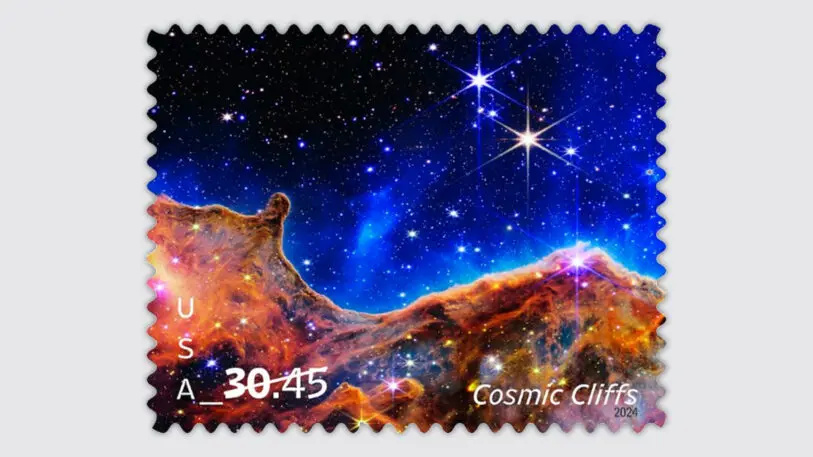In 2022, when NASA released some of the first photos the James Webb Space Telescope had captured of the universe, they sold like hotcakes. Pillars of Creation—three striking towers of gas and dust that look like arches and spires rising out of a desert landscape—were slapped on T-shirts and printed on mouse pads. Cosmic Cliffs, which resembles jagged mountains on a moonlit evening, starred in wildly intricate jigsaw puzzles. Many of these objects hit the internet soon after the images were unveiled. But another object has been in the works for more than a year: It’s sticky, flat, and significantly smaller than anything you’ve seen the cosmos printed on.
The U.S. Postal Service recently released two Priority Mail stamp designs of Pillars of Creation and Cosmic Cliffs. These stamps, like every other stamp issued by the USPS, have to go through a long and rigorous process—sometimes extending to three years or more—before you can stick them on your envelope and slip them in a mailbox. Shepherding that process is a team of four art directors. One of them is named Greg Breeding.
Breeding is cofounder of a graphic design company called Journey Group, but he spends half his time bringing Postal Service stamps to life. He has held this position for 12 years, and in that time, he has designed more than 100 stamps, including a Mayflower in Plymouth Forever Stamp, stamps featuring droids from Star Wars, and a Dungeons & Dragons stamp to commemorate the role-playing game’s 50th anniversary.

Breeding equates his role to that of a film director or the conductor of an orchestra. “I’m not playing, but I’m leading the music,” he told me on a recent phone call. The designer doesn’t get to choose what goes on the stamp—that’s to the Citizens’ Stamp Advisory Committee, which was established in 1957 and culls through about 40,000 idea submissions from the public every year.
Choosing from those ideas isn’t easy, but there are a few requirements, the most important of which is that every stamps has to tell “the American story.” This could mean telling narratives that have been overlooked or inadequately represented, like spotlighting marginalized communities. It could also mean stories that reflect what’s happening in pop culture, like Star Wars, Batman, Barbie (the doll, not the movie), or the world obsessing over the dazzling James Webb Space Telescope images.
According to a spokesperson, the USPS introduced art directors into this process at least 35 years ago, before which stamps were designed by an internal art department. Breeding says two of his peers, both women, have been designing stamps since the 1990s.
From the cosmos to your mailbox
Once the committee approves a particular stamp, it assigns an art director to carry the project forward. Art directors then work with artists, photographers, and illustrators to turn an idea or a subject into a stamp.

But that process was a bit different for the James Webb stamps. For one, there was no need for a concept, and no need for a photographer. The James Webb Space Telescope had already delivered on that front.
So what took so long? Pillars of Creation came out in October 2022. Cosmic Cliffs was released in July 2022. Breeding says the Postal Service knew it wanted to turn these images into stamps almost as soon as they came out because they reflect “a quintessentially American story.” But bringing a stamp to life isn’t as easy as slapping an image on a jagged-edged piece of paper.
Once the design is somewhat final, it has to get the legal department’s approval to ensure, “from every conceivable angle,” that the illustration or the subject portrayed doesn’t pose any PR risk to the Postal Service. By Breeding’s estimate, about a quarter of the assignments he’s received haven’t ended up going through this process, and about 10% of those he has designed haven’t gone to print, largely due to outside forces.
“Sometimes the best work is left on the cutting-room floor and it’s not because the work is not approved, it’s because we can’t clear the rights with someone who owns the rights or we’ve discovered a reputational risk, or there’s been some legal exposure we didn’t see going into it,” he says.
When everything is approved, the stamps are printed by the billions at two security printers: Ashton Potter in Williamsville, New York, and Banknote Corp. of America in Greensboro, North Carolina.
The world’s smallest canvas
Stamps may be small, but they are a window into a country’s history, past and present. They are, perhaps, the world’s tiniest branding canvas, and by sticking them on our letters and packages, we take part in that storytelling.
The problem is, we’re mailing fewer and fewer letters and packages. In 2023, the USPS produced 13.3 billion stamps, which sounds like a lot, but it’s just a fraction of what it produced in 1991 (54 billion). The decline isn’t all that surprising considering the increasingly digital world we live in, but according to Breeding, it doesn’t signal the death of the stamp. Au contraire. “If you want to send a thank-you card or you want to express a sentiment and you want it to be special,” he says, “you’ll write it and you’ll put a stamp on it and mail it.”
Recognize your brand’s excellence by applying to this year’s Brands That Matter Awards before the early-rate deadline, May 3.
